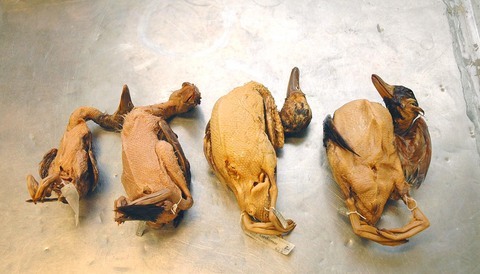Science moves in mysterious ways, and sometimes what seems like the end of the story is really just the beginning. Or, at least, that is what some researchers are thinking as they scratch their heads over the weird genetic sequence of the 1918 flu virus.
Dr. Jeffery Taubenberger, a molecular pathologist at the Armed Forces Institute of Technology who led the research team that reconstructed the long-extinct virus, said that a few things seemed clear.
The 1918 virus appears to be a bird-flu virus. But if it is from a bird, it is not a bird anyone has studied before. It is not like the A(H5N1) strain of bird flus in Asia, which has sickened at least 116 people, and killed 60. It is not like the influenza viruses that infect fowl in North America.

PHOTO: NY TIMES NEWS SERVICE
Yet many researchers believe that the 1918 virus, which caused the worst infectious disease epidemic in human history, is a bird-flu virus. And if so, it is the only one that has ever been known to cause a human pandemic.
That, Taubenberger said, gives rise to a question. Are scientists looking for the next pandemic flu virus in all the wrong places?
"I can't even assign a hemisphere," he said. "It just came from somewhere else. Maybe it's in pigeons. Or in songbirds."
"It's weird, it's really weird," he added. "My view is to be undogmatic as possible and just try to follow the data. This is the result we get. The question is: What does it mean?"
Taubenberger's question emerged from the science fiction-like search for the 1918 virus that eventually led to its reconstruction.
A decade ago, Taubenberger and his colleagues found shards of the extinct virus in two fingernail-size snippets of formaldehyde-soaked lung tissue from two soldiers and from the frozen lung of an Inuit woman who died of the flu in 1918 and was buried in permafrost. Slowly and pain-stakingly, they fished out the tiny fragments of viral genes and began reconstructing them.
The first gene they sequenced was the one that codes for the hemagglutinin protein on the virus' surface. Immediately, Taubenberger and his colleagues were struck by an oddity: The chain of nucleotides that coded for the amino acids in the protein were arranged differently from those found in any other bird flu.
The genetic code is flexible; there is more than one way that a group of three nucleotides can be arranged to code for the same amino acid.
But every bird-flu virus ever studied used the same spellings for the hemagglutinin amino acids. Not the 1918 flu.
There were two possibilities, Taubenberger thought. One was that bird flus have evolved over the decades and that back in 1918, the amino acids in bird viruses were simply coded differently.
Another was that if the 1918 flu virus came from a bird, it was no bird that anyone had considered before.
"We decided there was no way to address this," Taubenberger said. After all, the birds from 1918 were long gone, and their viruses had died with them.
Then Dr. Thomas Fanning, a scientist in Taubenberger's group, mentioned that he had a friend at the Smithsonian who worked at the National Museum of Natural History in Washington. It had several thousand preserved birds from the early 20th century that were floating in Mason jars of alcohol.
From there, they reached James Dean, a supervisor in the division of birds at the museum, who sent Taubenberger a computer printout of the birds in the museum's collection -- hundreds of birds, with notes telling the species and the exact times and places where they were collected. But which to choose?
Taubenberger consulted with one of the leading experts on bird flus, Richard Slemons of Ohio State, who chose 40 birds on the museum's list, all waterfowl collected around 1918. The museum found 25 of them.
The scientists took tiny pinches of tissue from passages of the birds' excretory tracts, or cloacas, and Taubenberger looked for flu viruses in the tissue. Six of the birds had a flu virus. The genetic coding for the amino acids in those viruses was exactly like that in bird flu viruses today, Taubenberger found.
In fact, the viruses had not even evolved. Human influenza viruses change every year, mutating slightly so they can reinfect people who had just had the flu and developed antibodies against it. But birds, Slemons said, do not have much of an immune response to influenza, and so there is no particular pressure for the virus to mutate.
Another reason the viruses stay the same, he said, is that some birds live for only a couple of years and so, every year, the viruses have a new bird population to infect. Finally, he said, birds are chronically infected with lots of flu viruses at once, and all the viruses coexist peacefully.
"There are so many that there is no selective pressure on any virus," he said.
But if bird viruses do not evolve and if the waterfowl viruses in 1915 and 1916 look just like bird viruses today, where did the 1918 virus come from? Or was it really a bird virus?
After all, at the time that he looked at the Smithsonian birds, Taubenberger had reconstructed only part of the virus' genetic sequence. Maybe when he had the whole thing, the picture would change.
It did not. The entire sequence, published last month in Nature, had the distinctive protein structures of a bird virus, he said. And it had that same peculiar way of spelling its amino acids.
When he compared the 1918 virus with today's human flu viruses, Taubenberger noticed that it had alterations in just 25 to 30 of the virus' 4,400 amino acids. Those few changes turned a bird virus into a killer that could spread from person to person.
Taubenberger noticed that, so far, the A(H5N1) viruses in Asia have just a few of those changes. They do not, however, have the unusual ways of coding the amino acid instructions that the 1918 virus had. So are the Asian bird viruses on their way to becoming pandemic viruses, or not?
Some experts like Dr. Peter Palese of the Mount Sinai School of Medicine in New York say the A(H5N1) flu viruses are a false alarm. He notes that studies of serum collected in 1992 from people in rural China indicated that millions of people there had antibodies to the A(H5N1) strain.
Despite that, and the fact that those viruses have been circulating in China more than a dozen years, almost no human-to-human spread has occurred. "The virus has been around for more than a dozen years, but it hasn't jumped into the human population," Palese said. "I don't think it has the capability of doing it."
Taubenberger said he could argue it either way.
"It's a nasty virus," he said. "It is highly virulent in domestic birds and wild birds. The fact that it has killed half the humans it has infected makes it of concern, and the fact that it shares some features with the 1918 virus makes it of concern.
"But the fact that it has circulated in Asia for years and hasn't caused a pandemic argues against it. Maybe there are some biological barriers we don't understand."

Taiwan Power Co (Taipower, 台電) and the New Taipei City Government in May last year agreed to allow the activation of a spent fuel storage facility for the Jinshan Nuclear Power Plant in Shihmen District (石門). The deal ended eleven years of legal wrangling. According to the Taipower announcement, the city government engaged in repeated delays, failing to approve water and soil conservation plans. Taipower said at the time that plans for another dry storage facility for the Guosheng Nuclear Power Plant in New Taipei City’s Wanli District (萬里) remained stuck in legal limbo. Later that year an agreement was reached

What does the Taiwan People’s Party (TPP) in the Huang Kuo-chang (黃國昌) era stand for? What sets it apart from their allies, the Chinese Nationalist Party (KMT)? With some shifts in tone and emphasis, the KMT’s stances have not changed significantly since the late 2000s and the era of former president Ma Ying-jeou (馬英九). The Democratic Progressive Party’s (DPP) current platform formed in the mid-2010s under the guidance of Tsai Ing-wen (蔡英文), and current President William Lai (賴清德) campaigned on continuity. Though their ideological stances may be a bit stale, they have the advantage of being broadly understood by the voters.

In a high-rise office building in Taipei’s government district, the primary agency for maintaining links to Thailand’s 108 Yunnan villages — which are home to a population of around 200,000 descendants of the Chinese Nationalist Party (KMT) armies stranded in Thailand following the Chinese Civil War — is the Overseas Community Affairs Council (OCAC). Established in China in 1926, the OCAC was born of a mandate to support Chinese education, culture and economic development in far flung Chinese diaspora communities, which, especially in southeast Asia, had underwritten the military insurgencies against the Qing Dynasty that led to the founding of

It’s fairly well established that strength training is helpful at every age: as well as building muscle, it strengthens tendons and ligaments, increases bone density and seems to have protective effects against everything from osteoporosis to dementia. But a new study based on data collected over two decades in Rio de Janeiro, Brazil, suggests that another physical attribute might be just as important — and it’s one that declines even faster than strength as the years go by. The good news? It might also be less uncomfortable, and even slightly safer, to improve. Also, it will probably make you better